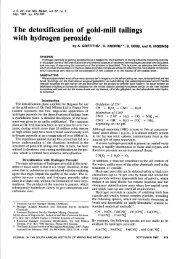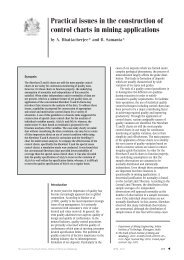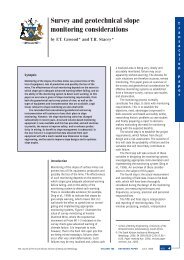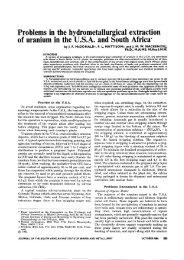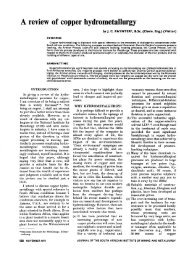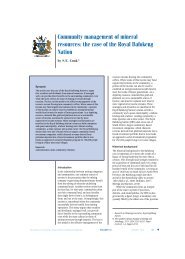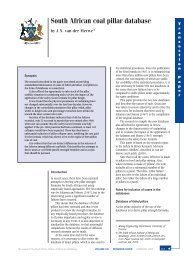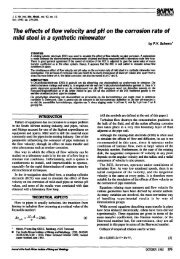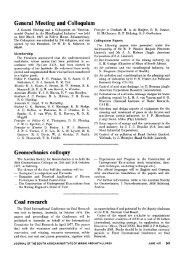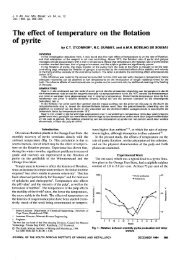Fundamental Studies of the Flotation Process: - saimm
Fundamental Studies of the Flotation Process: - saimm
Fundamental Studies of the Flotation Process: - saimm
Create successful ePaper yourself
Turn your PDF publications into a flip-book with our unique Google optimized e-Paper software.
development <strong>of</strong> generalised methods for <strong>the</strong> control<br />
<strong>of</strong> flotation processes.<br />
(2) The extension <strong>of</strong> <strong>the</strong> scope <strong>of</strong> <strong>the</strong> process to<br />
combinations <strong>of</strong> minerals that are not readily<br />
separated to be optimized, to minerals that are not<br />
flotable with existing reagents, and to <strong>the</strong> coarse<br />
and fine sizes <strong>of</strong> particles that are less amenable<br />
to <strong>the</strong> process. Within this aim is included <strong>the</strong><br />
development <strong>of</strong> new reagents, new machines,<br />
and new techniques.<br />
(3) A more-complete understanding <strong>of</strong> <strong>the</strong> mechanism<br />
<strong>of</strong> <strong>the</strong> different processes taking place<br />
during flotation. Understanding <strong>of</strong> <strong>the</strong> physical and<br />
mechanical aspects could be <strong>of</strong> importance in<br />
fur<strong>the</strong>ring aim (1) above; <strong>the</strong> understanding <strong>of</strong><strong>the</strong><br />
chemical aspects would assist in realizing aim (2),<br />
and is essential to <strong>the</strong> solution <strong>of</strong> <strong>the</strong> important<br />
problem associated with <strong>the</strong> fact that nominally<br />
identical minerals can show significantly different<br />
behaviour in flotation.<br />
Three essentially different methods can be used in <strong>the</strong><br />
investigation <strong>of</strong> flotation. Firstly, <strong>the</strong> empirical (trialand-error)<br />
method in which previous experience is applied<br />
to new material by way <strong>of</strong> systematic process testing.<br />
For all its unwieldiness, this is <strong>the</strong> only technique by<br />
which processes can be developed and proved at <strong>the</strong><br />
present time. Secondly, <strong>the</strong> chemical-engineering method.<br />
This is a syn<strong>the</strong>tic approach that concentrates on <strong>the</strong><br />
mixing and transport aspects, and is designed to meet<br />
<strong>the</strong> first and, to a lesser extent, <strong>the</strong> second <strong>of</strong> <strong>the</strong> aims<br />
set out above. It seeks to characterize flotation as a rate<br />
process and express characteristics <strong>of</strong> a plant as a ma<strong>the</strong>matical<br />
model that relates all <strong>the</strong> most important<br />
factors governing <strong>the</strong> operation <strong>of</strong> <strong>the</strong> process. A satisfactory<br />
model would indicate how <strong>the</strong> process should be<br />
operated for greatest efficiency. Thirdly, <strong>the</strong> physicochemical<br />
approach. This analytical approach is directed<br />
towards <strong>the</strong> realization <strong>of</strong> both <strong>the</strong> second and third<br />
aims set out above. It is based on <strong>the</strong> premise that <strong>the</strong><br />
primary, if not <strong>the</strong> most important, factor governing <strong>the</strong><br />
efficiency and selectivity is <strong>the</strong> proper conditioning <strong>of</strong><br />
<strong>the</strong> solid-solution and air-solution interfaces so that<br />
collisions between <strong>the</strong>m are fruitful and selective. It<br />
<strong>the</strong>refore seeks to understand <strong>the</strong> nature and <strong>the</strong> mechanism<br />
<strong>of</strong> <strong>the</strong> chemical and physical reactions taking<br />
place at and between <strong>the</strong> interfaces.<br />
At <strong>the</strong> N.I.M. all three approaches are applied to <strong>the</strong><br />
study <strong>of</strong> flotation. The Ore Dressing Division carries out<br />
empirical development in relation to specific ores, <strong>the</strong><br />
University Research Group in <strong>the</strong> Department <strong>of</strong><br />
Chemical Engineering at <strong>the</strong> University <strong>of</strong> Natal concerns<br />
itself with an engineering approach based on<br />
ma<strong>the</strong>matical modelsl, and <strong>the</strong> Mineral and <strong>Process</strong><br />
Chemistry Division studies <strong>the</strong> physicochemical aspects<br />
<strong>of</strong> flotation.<br />
PHYSICOCHEMICAL RESEARCH WORK<br />
Fig. 1 presents a break-down <strong>of</strong> <strong>the</strong> flotation process in<br />
<strong>the</strong> form <strong>of</strong> a flow diagram, which shows <strong>the</strong> most important<br />
stages that take place and <strong>the</strong> interaction take<br />
over between <strong>the</strong>m. The process is manifestly a complex<br />
one. The heterogeneous mixture <strong>of</strong> solid particles that<br />
make up a typical flotation feed is concentrated and<br />
separated through interaction with chemical reagents,<br />
air, and energy. Important interactions take place at<br />
three interfaces-<strong>the</strong> solid-solution, solid-air, and airsolution<br />
interfaces-and in <strong>the</strong> solution phase.<br />
Before a detailed consideration <strong>of</strong> some <strong>of</strong> <strong>the</strong> various<br />
research projects that have been undertaken and are<br />
under way in <strong>the</strong> Mineral and <strong>Process</strong> Chemistry<br />
Division, it is necessary to explain <strong>the</strong> principles that<br />
have governed <strong>the</strong> general direction <strong>of</strong> <strong>the</strong> work.<br />
At <strong>the</strong> outset it was accepted that it would not be<br />
possible to work immediately on all stages <strong>of</strong> <strong>the</strong> process<br />
(c, d, e, and g <strong>of</strong> Fig. 1) in which important chemical<br />
interactions take place. It would be preferable to direct<br />
a concerted effort at one <strong>of</strong> <strong>the</strong> stages and to acquire on<br />
that one aspect a sound foundation <strong>of</strong> knowledge and<br />
experience on which a wider understanding could be<br />
built. Militating against a more general attack on <strong>the</strong><br />
subject was not only <strong>the</strong> considerable complexity <strong>of</strong> <strong>the</strong><br />
physicochemical interactions taking place, but also<br />
<strong>the</strong> uncertainties and contradictions in <strong>the</strong> existing<br />
knowledge <strong>of</strong> <strong>the</strong> subject - a circumstance that made it<br />
difficult to choose a secure point <strong>of</strong> knowledge from which<br />
to mount new research programmes.<br />
It was decided that all studies should be conducted on<br />
as rigid and quantative a basis as rigidly as possible. At<br />
<strong>the</strong> time <strong>the</strong> work was started, <strong>the</strong>re existed a certain<br />
general framework <strong>of</strong> understanding that explained,<br />
probably correctly, how hydrophobicity developed from<br />
<strong>the</strong> oriented absorption <strong>of</strong> collector molecules at <strong>the</strong><br />
mineral surface. However, this general understanding<br />
did not explain <strong>the</strong> processes taking place in sufficient<br />
detail to be <strong>of</strong> practical assistance in process design and<br />
control, or in <strong>the</strong> prediction <strong>of</strong> <strong>the</strong> behaviour <strong>of</strong> flotation<br />
systems. It was considered that fur<strong>the</strong>r progress would<br />
be possible only on <strong>the</strong> basis <strong>of</strong> a very much more quantitative<br />
and exact knowledge <strong>of</strong> <strong>the</strong> reactions taking<br />
place. The decision to adopt this type <strong>of</strong> very thorough<br />
approach carried with it <strong>the</strong> acceptance that <strong>the</strong> progress<br />
<strong>of</strong> <strong>the</strong> work might necessarily be slow and that, initially<br />
at least, <strong>the</strong> field <strong>of</strong> endeavour would have to be<br />
severely restricted.<br />
The aspect <strong>of</strong> <strong>the</strong> process chosen for initial study was<br />
<strong>the</strong> interaction between <strong>the</strong> mineral surface and reagents<br />
in solution (see Fig. 1, stage (d)), and <strong>the</strong> fields in which<br />
work has been carried out are shown in Fig. 2. The<br />
following sections describe a few <strong>of</strong> <strong>the</strong> specific problems<br />
that have been undertaken and <strong>the</strong> conclusions that have<br />
been reached will be outlined and placed in context with<br />
<strong>the</strong> general state <strong>of</strong> knowledge <strong>of</strong> <strong>the</strong> particular subject.<br />
THE INTERACTION BETWEEN SULPHIDE<br />
MINERALS AND THIOL REAGENTS14<br />
To place <strong>the</strong> work that has been done at N.I.M. in its<br />
context, it is necessary to summarize <strong>the</strong> general state <strong>of</strong><br />
knowledge <strong>of</strong> <strong>the</strong> interactions that take place between<br />
thiol reagents and sulphide minerals.<br />
By <strong>the</strong> early 1950's, a clear picture <strong>of</strong><strong>the</strong> events taking<br />
place when thiol reagents interact with sulphide mineral<br />
surfaces appeared to be emerging. It was known that<br />
sulphide surfaces abstracted thiols from aqueous<br />
solution and that in <strong>the</strong> process anions such as sulphates,<br />
JOURNAL OF THE SOUTH AFRICAN INSTITUTE OF MINING AND METALLURGY FEBRUARY 1972 197




